Difference between Protoplasm and Cytoplasm
Introduction
One of the fascinating topics in biology is the study of cells. Understanding the difference between protoplasm and cytoplasm is an essential part of cell biology. Protoplasm and cytoplasm are terms that describe the basic components of a cell. In this article, we will explore the differences between these two terms.
What is Protoplasm?
Protoplasm is a term used to describe the living matter found in all cells. This living matter includes the nucleus and cytoplasm. Protoplasm consists of various organic and inorganic molecules, including proteins, lipids, carbohydrates, and nucleic acids.
The protoplasm also contains various organelles such as mitochondria, ribosomes, and endoplasmic reticulum. These organelles are responsible for carrying out specific functions within the cell, such as energy production and protein synthesis.
What is Cytoplasm?
Cytoplasm is a term used to describe the non-living matter that fills the cell. It is a gel-like substance that surrounds the nucleus and organelles. The cytoplasm consists of various molecules such as water, ions, enzymes, and other biomolecules.
The cytoplasm also plays an essential role in maintaining the shape and structure of the cell. It provides a medium for intracellular communication and allows materials to move within the cell.
The Key Differences between Protoplasm and Cytoplasm
1. Composition: Protoplasm is living matter, while cytoplasm is non-living matter.
2. Location: Protoplasm is found in the nucleus and cytoplasm, while cytoplasm is found in the outer space of the nucleus.
3. Function: Protoplasm is responsible for carrying out the metabolic functions of the cell, while cytoplasm provides a medium for intracellular communication and allows materials to move within the cell.
4. Content: Protoplasm contains various molecules such as proteins, lipids, carbohydrates, and nucleic acids, while cytoplasm contains water, ions, enzymes, and other biomolecules.
Conclusion
In conclusion, the difference between protoplasm and cytoplasm is vital in understanding the basic components of a cell. Protoplasm is the living matter that includes the nucleus and cytoplasm containing various organic and inorganic molecules and organelles. Cytoplasm, on the other hand, is a non-living gel-like substance that fills the cell, provides a medium for intracellular communication, and maintains the cell’s shape and structure. Understanding the difference between these two terms is crucial in comprehending the fundamental aspects of cell biology.
Table difference between protoplasm and cytoplasm
| Protoplasm | Cytoplasm |
|---|---|
| Refers to the entire living matter present in the cell including the nucleus. | Refers to the fluid present inside the cell membrane which is responsible for various cellular processes. |
| It includes both the living and non-living components of the cell. | It includes only the living components of the cell. |
| Transports nutrients, waste products and energy in the cell. | Acts as a site for various metabolic activities. |
| Consists of both cytoplasm and nucleoplasm. | It is only present in the cytoplasm. |
| Found in both prokaryotic and eukaryotic cells. | Found in all living cells. |

